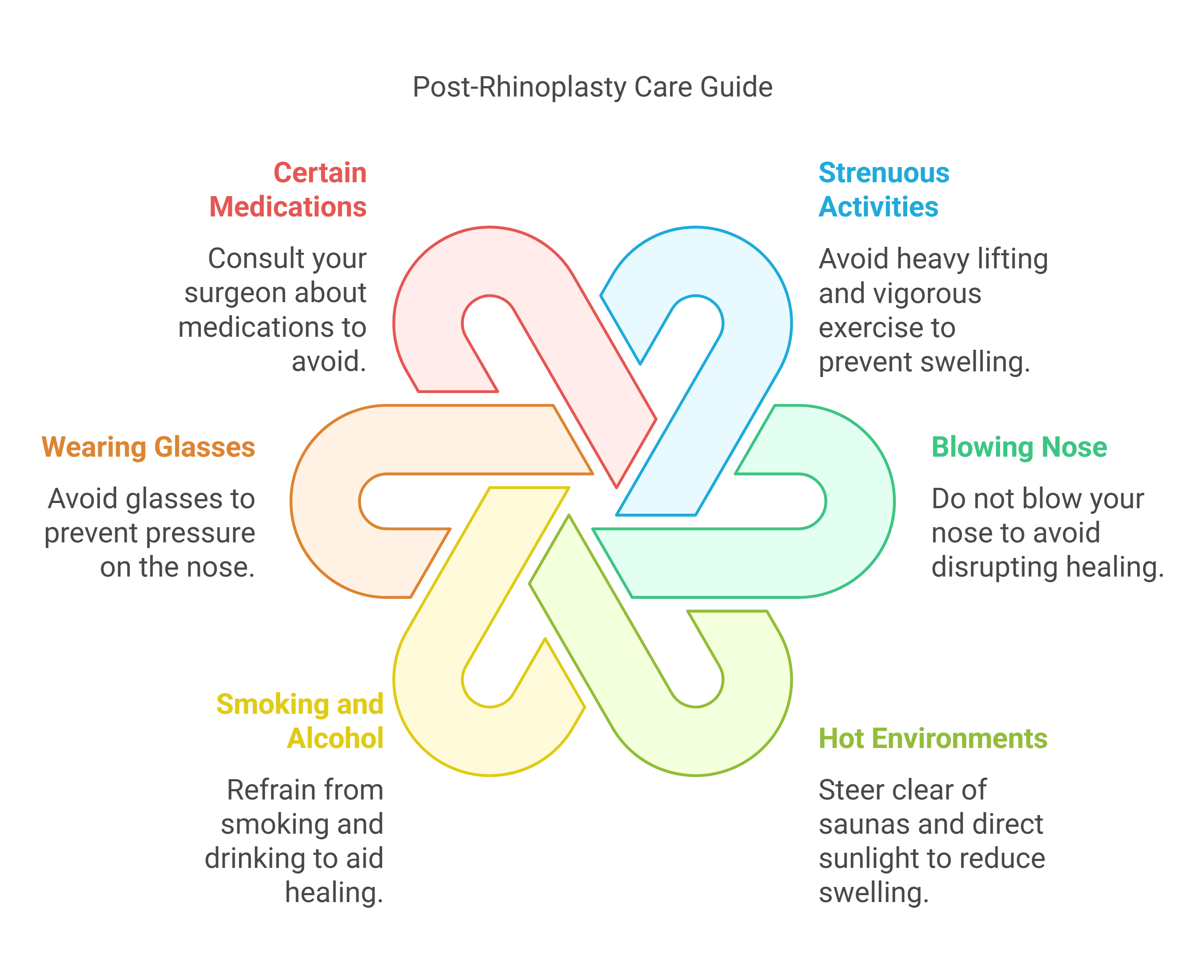Rhinoplasty is a popular surgical procedure aimed at reshaping the nose for aesthetic or functional reasons. Many people considering this operation often wonder about the longevity of the results. Understanding how long rhinoplasty lasts involves looking at various factors, including surgical techniques, individual healing processes, and how natural ageing can affect the nose over time. In this article, we’ll break down what you need to know about the durability of rhinoplasty results and how to maintain them.
Key Takeaways
- Rhinoplasty results are generally permanent but can be influenced by natural ageing.
- Post-surgery care is vital for maintaining results over time.
- Different surgical techniques can affect the longevity of results.
- Genetics play a significant role in how long the changes last.
- Expect to see final results after about a year, with ongoing changes possible.
Understanding Rhinoplasty Results
Rhinoplasty, often called a nose job, is a surgical procedure designed to reshape the nose and improve its overall appearance. It’s a big decision, and understanding what to expect in terms of results is key. Let’s break down what you can realistically anticipate after undergoing rhinoplasty.
Permanent Changes to Nasal Structure

One of the primary goals of rhinoplasty is to create lasting changes to the structure of your nose. This involves reshaping bone and cartilage to achieve the desired aesthetic outcome.
Once the procedure is complete and the initial healing phase has passed, the underlying structure of your nose will be permanently altered. However, it’s important to remember that the final appearance will continue to refine over time as swelling subsides and tissues settle.
It’s also worth noting that a small percentage of patients may need a revision surgery to fine-tune the results.
Ageing and Natural Changes
While rhinoplasty provides permanent changes to the nasal structure, the nose, like all other parts of the body, will continue to age. This means that over many years, natural changes associated with ageing can affect the appearance of your nose. Skin loses elasticity, and cartilage can weaken, which may subtly alter the shape of the nose.
However, the fundamental improvements achieved through rhinoplasty should remain noticeable. An ageing rhinoplasty is something to consider for long-term satisfaction.
Individual Variability in Results
It’s crucial to understand that everyone’s experience with rhinoplasty is unique. Factors such as skin thickness, the extent of the initial nasal deformity, and individual healing responses can all influence the final outcome.
While your surgeon will strive to achieve the desired results, it’s important to have realistic expectations and understand that minor variations are possible. Seeing before and after rhinoplasty photos can help you visualise potential outcomes.
It’s important to have open communication with your surgeon throughout the entire process. Discuss your goals, concerns, and expectations in detail to ensure that you are both on the same page. This will help to maximise your satisfaction with the final results.
Here’s a simple breakdown of what to expect in the first year:
- Months 1-3: Most of the swelling goes down, and you’ll start to see the new shape of your nose.
- Months 4-6: The nose continues to heal, and you might notice small changes in how it looks.
- Months 7-18: By the end of the first year, your nose should be settled into its final shape. Any small issues should be sorted out by now.
Factors Influencing Longevity
So, you’re thinking about getting a rhinoplasty? That’s great! One of the big questions people have is, ‘How long will it actually last?’ Well, it’s not quite as simple as setting a timer. Several things can affect how your rhinoplasty holds up over the years. Let’s break it down.
Surgical Techniques and Their Impact
The type of surgical approach your surgeon uses plays a massive role. Modern techniques aim for long-lasting results by focusing on structural support. Older, more ‘reductive’ methods sometimes lead to issues down the line.
Basically, if the surgeon removes too much cartilage or doesn’t properly support the remaining structure, your nose might change in ways you don’t like as you age. Choosing a surgeon experienced in advanced techniques is key.
Post-Surgery Care Importance
Okay, you’ve had the surgery, now what? How you look after yourself afterwards really matters. Think of it like this: the surgeon has laid the foundation, and it’s your job to protect it.
- Follow your surgeon’s instructions to the letter.
- Attend all follow-up appointments.
- Report any concerns promptly.
- Avoid strenuous activities that could risk trauma to the nose during the initial healing phase.
Proper aftercare can significantly extend the life of your rhinoplasty. It’s about being proactive and responsible for your recovery.
Genetic Factors Affecting Results
Genetics play a role in, well, pretty much everything, and rhinoplasty is no exception. Your skin type, cartilage quality, and even how your body heals are all influenced by your genes. For example, someone with thicker skin might see subtle changes over time compared to someone with thinner skin.
While you can’t change your genetics, understanding them can help you set realistic expectations and work with your surgeon to plan for the best possible long-term outcome. It’s also worth noting that genetics influence how your face ages in general, which can indirectly affect the appearance of your nose after rhinoplasty.
Recovery Timeline After Rhinoplasty

What happens after the surgery? Let’s break down the recovery timeline so you know what to expect. It’s not a sprint, it’s more of a marathon, but with the right care, you’ll get there.
Initial Recovery Phase
Right after your rhinoplasty, expect some swelling and bruising. It’s totally normal. You’ll probably have a splint and maybe some packing in your nose. The first week is usually the toughest, so plan to take it easy. Here’s what you can expect:
- Swelling and bruising around the eyes and nose.
- Nasal congestion and difficulty breathing through your nose.
- Pain or discomfort, which can be managed with medication.
- The need to keep your head elevated, especially when sleeping.
During this initial phase, following your surgeon’s instructions is super important. This includes taking prescribed medications, keeping your head elevated, and avoiding any strenuous activities. Think of it as a good excuse to binge-watch your favourite shows!
Long-Term Healing Process
After the first couple of weeks, things start to improve. The splint comes off, and the bruising begins to fade. However, it’s important to remember that your nose is still healing internally. This phase can last for several months, even up to a year. During this time:
- The majority of the visible swelling will subside.
- You might experience subtle changes in the shape of your nose as it settles.
- It’s important to avoid any trauma to the nose, such as contact sports.
- Follow-up appointments with your surgeon are essential to monitor your progress.
Asymmetrical healing is also something to be aware of. It’s when one side of your nose heals differently from the other, leading to temporary unevenness. Don’t panic! It’s a normal part of the process, and it usually resolves on its own. If you’re considering a nose job, understanding this process is key.
When to Expect Final Results
This is the million-dollar question, isn’t it? While you’ll see improvements relatively quickly, the final results of your rhinoplasty can take up to a year, or even longer, to fully materialise. Patience is key here. Remember that:
- Subtle swelling can persist for many months, especially in the tip of the nose.
- The tissues and cartilage need time to fully settle into their new position.
- Regular check-ups with your surgeon will help ensure everything is healing as expected.
So, there you have it – a realistic overview of the rhinoplasty recovery timeline. It’s a journey, but with proper care and a bit of patience, you’ll be thrilled with the results.
Types of Rhinoplasty Procedures
There are different ways to approach the surgery, and the best option for you depends on what you’re hoping to achieve. Let’s have a look at some common types.
Open Rhinoplasty Overview
Open rhinoplasty is often used for more complex reshaping. The surgeon makes a small cut across the columella (the bit between your nostrils) to lift the skin and fully expose the underlying bone and cartilage. This gives them a really clear view and allows for significant alterations. It’s like opening the bonnet of a car to get a good look at the engine. Recovery might take a bit longer compared to other methods, but the precision it offers can be worth it, especially if you need substantial work done. It’s a common choice for those needing functional corrections alongside aesthetic changes.
Closed Rhinoplasty Benefits
Closed rhinoplasty, on the other hand, is less invasive. The surgeon makes all the cuts inside your nose. This means no visible scars, which is a big plus for many people. It’s generally used for more minor adjustments. Recovery tends to be quicker, too. However, the surgeon has less visibility, so it might not be suitable for more complex cases.
Think of it as doing a quick repair job without taking everything apart. If you’re after subtle changes, this could be a good option. It’s worth noting that both open and closed techniques can address a deviated septum.
Suture Lift Rhinoplasty Explained
Suture lift rhinoplasty is a minimally invasive technique that uses sutures to reshape the nose. It’s a non-surgical option, so there are no incisions involved. This means less downtime and reduced risks compared to traditional surgery. It’s ideal for people who want subtle enhancements, like lifting the nasal tip or refining the bridge. The results aren’t as dramatic or permanent as with open or closed rhinoplasty, but it’s a good choice if you’re looking for a quick fix with minimal disruption. It’s like using clever tailoring to adjust the shape of something, rather than completely rebuilding it. This advanced nose reshaping technique is gaining popularity for its convenience and quick recovery.
Maintaining Your Rhinoplasty Results
Now, how do you make sure those results stick around for as long as possible? It’s not just about the surgery itself; what you do afterwards plays a massive role.
Importance of Sun Protection
Right, let’s talk about the sun. I know everyone bangs on about it, but seriously, it’s a big deal. UV rays can wreak havoc on your skin, and that includes the skin on your nose, especially after surgery. Sun damage can accelerate ageing and potentially affect the appearance of your rhinoplasty results.
- Always wear a broad-spectrum sunscreen with an SPF of 30 or higher.
- Reapply sunscreen every two hours, especially if you’re outdoors.
- Consider wearing a hat to provide extra shade for your face.
Avoiding Trauma to the Nose
This one seems obvious, but it’s worth spelling out. Your nose is going to be more vulnerable after surgery, so you need to be extra careful to avoid any bumps or knocks. Protecting your nose from trauma is key to maintaining the results of your rhinoplasty.
- Avoid contact sports or activities with a high risk of facial injury.
- Be mindful of your surroundings to prevent accidental bumps.
- If you wear glasses, make sure they fit properly and don’t put pressure on your nose. If you are looking for a more permanent solution, consider non-surgical rhinoplasty.
Healthy Lifestyle Choices
Okay, this isn’t just about your nose, but a healthy lifestyle will benefit your overall appearance and help maintain your rhinoplasty results. Think of it as an investment in yourself.
- Eat a balanced diet rich in vitamins and antioxidants.
- Stay hydrated by drinking plenty of water.
- Avoid smoking, as it can impair healing and accelerate ageing.
Looking after yourself is the best way to ensure your rhinoplasty results last. It’s about making smart choices every day to protect your investment and enjoy your new look for years to come.
Common Myths About Rhinoplasty
Rhinoplasty, like any popular cosmetic procedure, is surrounded by a fair few myths. It’s easy to get caught up in what you hear from friends, see online, or read in forums. Let’s debunk some of these common misconceptions to help you have a clearer understanding of what to expect.
Misconceptions About Longevity
One of the biggest myths is that a rhinoplasty result is set in stone the moment the bandages come off. This isn’t quite true. While the structural changes made during surgery are permanent, the nose will continue to subtly change over time due to ageing and other factors. It’s more about managing expectations and understanding the long game. A skilled surgeon will consider these long-term changes during the initial procedure to ensure lasting satisfaction.
Understanding Recovery Expectations
Another common myth is that the recovery from rhinoplasty is incredibly painful and debilitating. While there will be some discomfort, modern techniques and pain management strategies mean that most patients find the recovery manageable.
It’s more about patience and following your surgeon’s instructions carefully. Bruising and swelling are normal, but they will subside over time. The recovery timeline varies from person to person, but most people are back to their normal activities within a few weeks.
Debunking Aesthetic Concerns
Finally, there’s the myth that rhinoplasty always results in an obviously ‘done’ or unnatural look. This is often due to outdated surgical techniques.
A good surgeon aims for a result that is in harmony with your other facial features, creating a natural and balanced appearance. It’s about enhancing your existing beauty, not creating a completely new face. If you are looking to enhance both aesthetics and breathing, rhinoplasty can help.
Consultation and Planning for Rhinoplasty

Choosing the Right Surgeon
Finding the right surgeon is probably the most important part. It’s not just about qualifications (though those are vital, of course!). It’s about finding someone you trust, someone who understands your goals, and someone who communicates clearly.
Here’s a few things to consider:
- Check their credentials: Are they board-certified? How long have they been practising?
- Look at before-and-after photos: Do you like their aesthetic? Do their results look natural?
- Read reviews: What are other patients saying about their experience?
- Trust your gut: Do you feel comfortable with this person? Do they listen to your concerns?
Setting Realistic Expectations
Rhinoplasty can do amazing things, but it’s not magic. It’s important to have a clear understanding of what’s achievable and what’s not. Your surgeon should be able to explain the limitations of the procedure and help you visualise the potential results.
Remember, the goal is to enhance your natural features, not to create a completely different face. It’s about balance and harmony.
Preparing for Surgery
So, you’ve found your surgeon, you’ve set your expectations, and you’re ready to go. Now what? Well, there are a few things you can do to prepare for surgery and ensure a smooth recovery.
- Follow your surgeon’s instructions: This might include stopping certain medications or supplements.
- Quit smoking: Smoking can interfere with healing.
- Arrange for someone to drive you home: You won’t be able to drive yourself after surgery.
- Prepare your recovery space: Make sure you have everything you need within easy reach, like pillows, pain medication, and entertainment.
When considering rhinoplasty, the first step is to have a thorough consultation. This is your chance to discuss your goals and any concerns with a qualified expert. They will help you understand the process and what to expect.
Conclusion
Rhinoplasty can provide lasting results, often permanent, but various factors can influence how your nose may change over time. It’s essential to remember that while the surgical alterations are designed to be enduring, natural ageing and lifestyle choices can still play a role in the appearance of your nose.
By following your surgeon’s aftercare advice and maintaining a healthy lifestyle, you can help ensure your results remain as beautiful as possible for years to come. If you’re considering rhinoplasty, don’t hesitate to reach out for an expert consultation. We’re here to support you on your journey to achieving the look you desire.
Frequently Asked Questions
How long does it take to see the final results of a rhinoplasty?
You should start to notice changes in your nose about a week after the surgery when the splint is removed. However, it can take up to a year for your nose to fully settle into its new shape.
Will the results of rhinoplasty last forever?
Yes, the changes made during rhinoplasty are usually permanent. However, natural ageing and other factors can affect how your nose looks over time.
What can I do to help my nose heal faster after surgery?
To speed up healing, rest well, keep your head elevated while sleeping, and avoid any pressure on your nose. Applying cool compresses can also help reduce swelling.
Are there any risks involved with rhinoplasty?
Like any surgery, rhinoplasty comes with risks such as bleeding, infection, or dissatisfaction with the results. It’s important to discuss these with your surgeon.
How should I take care of my nose after rhinoplasty?
Follow your surgeon’s instructions carefully. Avoid strenuous activities, protect your nose from trauma, and use sunscreen to prevent skin damage.
Can rhinoplasty change my breathing?
Yes, rhinoplasty can improve breathing if there are structural issues in the nose. It’s important to discuss any breathing concerns with your surgeon beforehand.





